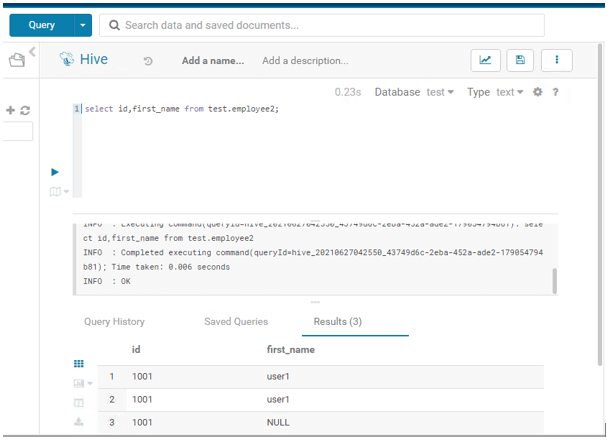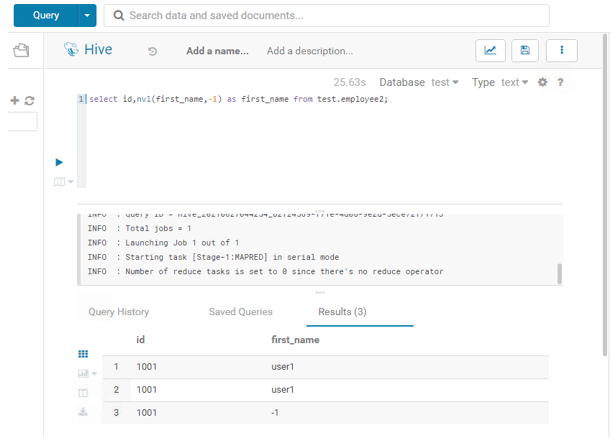Updated March 6, 2023
Introduction to Hive nvl
In the hive, we are dealing with a large amount of data as well as with large data set. In some cases, we are getting the null value in the tables. But in the analysis purpose, we need a meaning full data. In some case, we need a mechanism that it will identify the null value and it should be replace it with the meaning full value. It will help for the further analysis front. Here, the hive nvl function comes into the picture. It will help to replace the null value from the hive table and put the necessary value in place of the null value. We can use the hive nvl function with the multiple control statement also.
Syntax of Hive nvl Command
nvl(<Column name >,<Value that’s needs to be replace>)
1) nvl: In the hive service, we need to use the number of functions. The hive nvl function is one of the same functions. We can use the nvl function as the keyword in the hive query. It will update, we need to replace the null value in the table with the specific value. With the help of the nvl keyword, we can easily replace the null values from the hive table. But before triggering the nvl function, please understand the hive table structure and which values we need to replace with.
2) Column name: In the hive nvl function, we need to define the hive column name in it. It will help to understand which column we need to choose to identify the null values.
3) Value that’s needs to be replace: In the hive nvl function, we need to provide the necessary value. The same value will be replaced when any null value comes into the picture.
How nvl works in Hive?
In hive service, we are dealing with a huge amount of data and large datasets as well. It is a high probability that there are null values is present in the hive tables. It will be very difficult to identify the number of instances where there is null values occurs. With the help of the hive nvl function, it will be easy to identify the null values in the hive table and replace the null value with a specific or meaningful value. The hive nvl will use with the different control statement or the hive query. We need to pass the column name and the value that needs to be replaced. Then the nvl function will check on the specific table if the null values come then it will replace the null value with the provided value.
Below are the lists of conditional functions that can we use with the hive nvl.
1) IF(boolean testCondition, T valueTrue, T valueFalseOrNull) : We are having multiple and different type of the conditional function. The above conditional function is one of the best conditional functions in the hive ecosystem. It is mostly similar to the “IF” control statement. We can co-relate this “IF” control statement with the other programming language also. In the IF hive control statement, it will test the conditional functions which are provided under the hive IF control statement. If the provided expression is correct then it will return a necessary or corresponding result. The result will depend on whether the condition result is true or false (in some cases the result will come null also).
2) isnull(a): In the isnull conditional function, It will return a value as true if it is a NULL and false otherwise.
3) isnotnull(a): The isnotnull conditional function is the opposite of the isnull conditional function in other words we can say that this function is a negation of isnull conditional function. It will return the true value if it is not NULL and false otherwise.
4) CASE WHEN a THEN b [WHEN c THEN d]… [ELSE e] END : In the hive, we are able to test the sequential condition also. This conditional function will test the multiple conditions and check whether any of the present sequential condition or the expressions is true then it will return a corresponding or necessary result for the initial true condition. In the same conditional function, we can use the different operators like REGEXP, OR, IN (we can use them in the CASE expressions also).
5) CASE a WHEN b THEN c [WHEN d THEN e]… [ELSE f] END: It is similar to the above conditional function only. This conditional function will test the multiple conditions. But here we are providing the initial condition. It will depend on the requirement or the application code. It will check whether any of the present sequence condition or the expressions is true then it will return a corresponding or necessary result for the initial true condition. In the same conditional function, we can use the different operators like REGEXP, OR, IN (we can use them in the CASE expressions also).
6) NVL(arg1, arg2) : In this conditional function, we have provided different arguments. If the expression or the condition is null then it will return the expression. In some cases, if the result is not null then the second argument will be returned.
7) coalesce(value1, value 2, …) : In this conditional function, it will returns the first non-null value for the provided list (the value is provided in the arguments).
8) decode(<expr>, <search1>,<result1>, …<search N>, <result N>, <default>) : In this conditional function, It will help to compares an expression to one or multiple possible values which is provided in the conditional function. Once the necessary match will find then it will return the respective result.
Examples to understand Hive nvl Command
Hive nvl : Simple hive command
In the hive environment, we are able to replace the null value with specific value.
Command:
select id,nvl(first_name,-1) as first_name from test.employee2;
Explanation:
As per the above command, we are replacing the null value form with a -1 value.
Output:
Conclusion
We have seen the uncut concept of the “Hive nvl” with the proper example, explanation, and command with different outputs. It will help to identify the null values in the hive table and replace the null with the meaningful value.
Recommended Articles
This is a guide to Hive nvl. Here we discuss the Introduction, syntax, How nvl works in Hive?, Examples, and commands. You may also have a look at the following articles to learn more –





